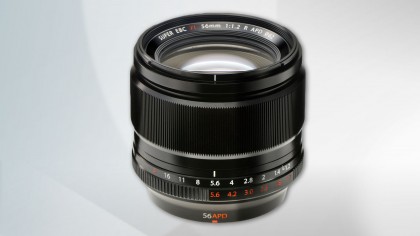Fuji's popular 56mm lens has had a filter added - isn't that just cheating?
Maybe they should have just got it right the first time

Canon has been going on for years about the wonderful irises it uses. Those in the best glass and L lenses feature eight or nine curved blades to create an almost perfectly circular aperture, and Canon says this is the magic answer to attractive out-of-focus highlights.
The quality of out-of-focus highlights has become a sort of photographic holy grail in recent times, with a great deal of emphasis and value placed, by manufacturers and pixel peepers alike, on the characteristics of the 'bokeh'* produced by any particular configuration of elements and apertures.
A critical component in the creation of good bokeh, as we all know by now, is the number of blades used in the aperture of the lens, so it would have been reasonably obvious to anyone that the seven blades of Fuji's original XF 56mm f/1.2 were not going to quite cut the mustard with those who like to look very closely at their pictures. In the '85mm f/1.2-alike' lens stakes, this model is up against Canon's eight blades, Panasonic's nine blades and the eight that even Samyang saw fit to use in its 85mm f/1.4 manual lens.
At f/4 the XF 56mm f/1.2 does produce some distinctly heptagonal highlights. Did Fuji's engineers not check this out before it launched the lens, or did they think it looked OK? Or perhaps this apodisation** filter version was planned all along.
We might wonder, and even be concerned, that Fuji is trying to paper over the cracks with this filter, to correct what it didn't quite manage in the first place. Or perhaps we should congratulate the ingenious idea and be pleased that now this lens will have probably the best looking bokeh in the whole school by far.

Firmware tricks
I suppose purists will be absolutely bothered that this lens has some intervention and internal manipulation to make it look good, but these days it is hard to get away from the fact that camera firmware and powerful processing engines are doing the same thing all the time to fix the short-comings of our equipment. Fuji is particularly proud of its Lens Modulation Optimiser technology that it uses in many of its X products –processing that exists to correct the flaws in its optical systems. All other camera brands do the same thing, but tend not to shout about it quite so much or give it a marketing name.
In-camera firmware is commonly used to pump away a cesspit of optical shame; darkening at the edges of the picture caused by poor sensor coverage, bent lines that are supposed to be straight, the coloured fringing that is caused by different wavelengths of light not focusing in the same place, as well as image noise created by short-comings in the way camera sensors record and report light. If some of us could see the unaltered images our cameras produce we'd be asking for a refund and taking up knitting instead.
Sign up for breaking news, reviews, opinion, top tech deals, and more.
Pride and perfection
But does it really matter what trickery goes on, so long as the pictures look good? If you think you are paying out for a good lens you might feel cheated that half of what you are buying is done in software not through the optics. We have to decide what is most important to us – the absolute quality of what we own, or the quality of what it produces.
Fuji's use of an apodisation filter is a clever, if not original (Minolta did it first in recent times) idea, and a neat way to solve a problem. Did the company really plan to have two versions of this lens – a £100-premium good one that shows up the short-comings of the other? I might be wrong, but I suspect not. If it was intended, it might have been more honest to announce them both at the same time. If not, this is certainly a cheaper fix than redesigning the lens to have nine aperture blades, though I think current XF56mm owners might feel less let down if they knew there was something more physically different about the new model than a circular graduated filter.